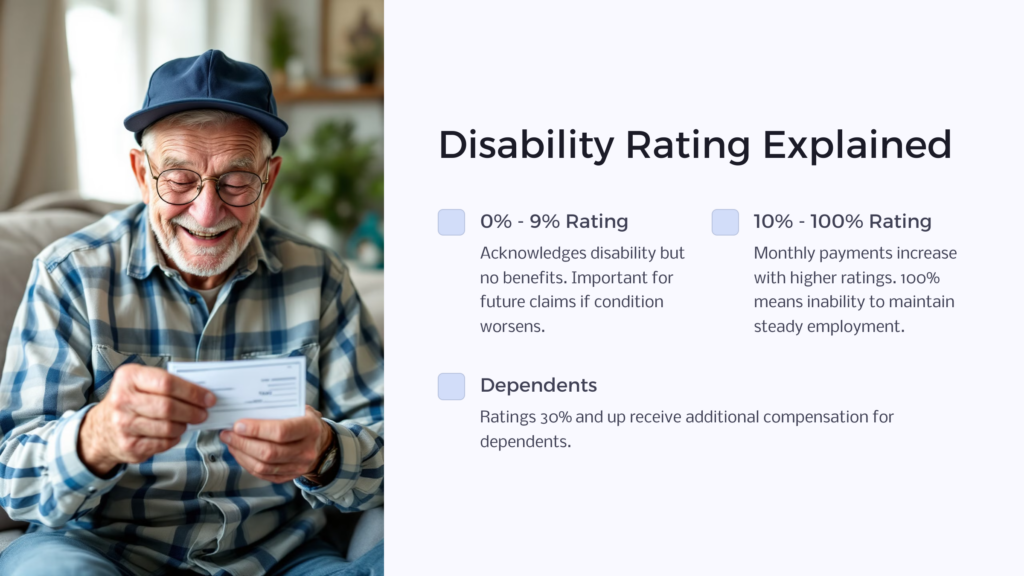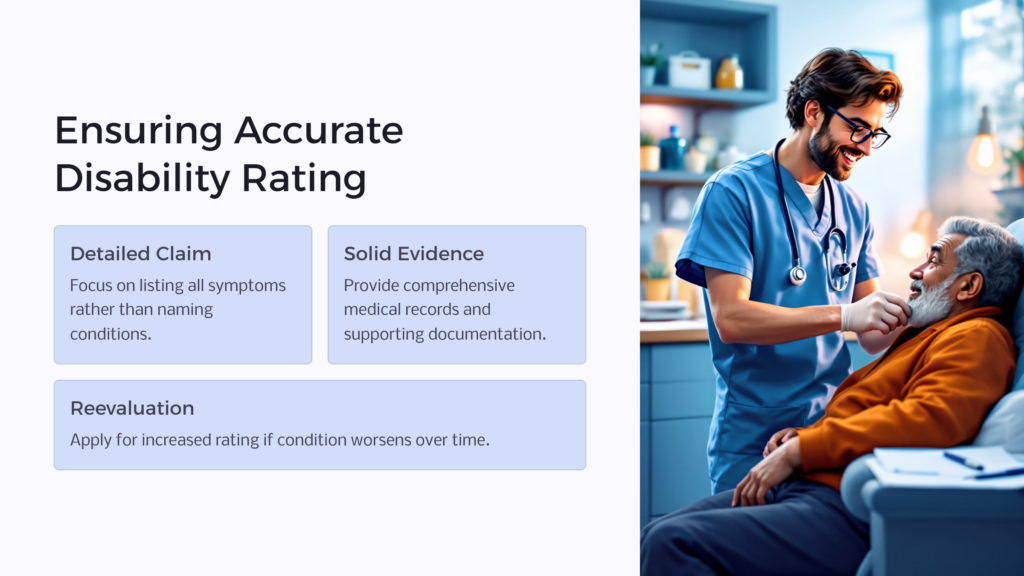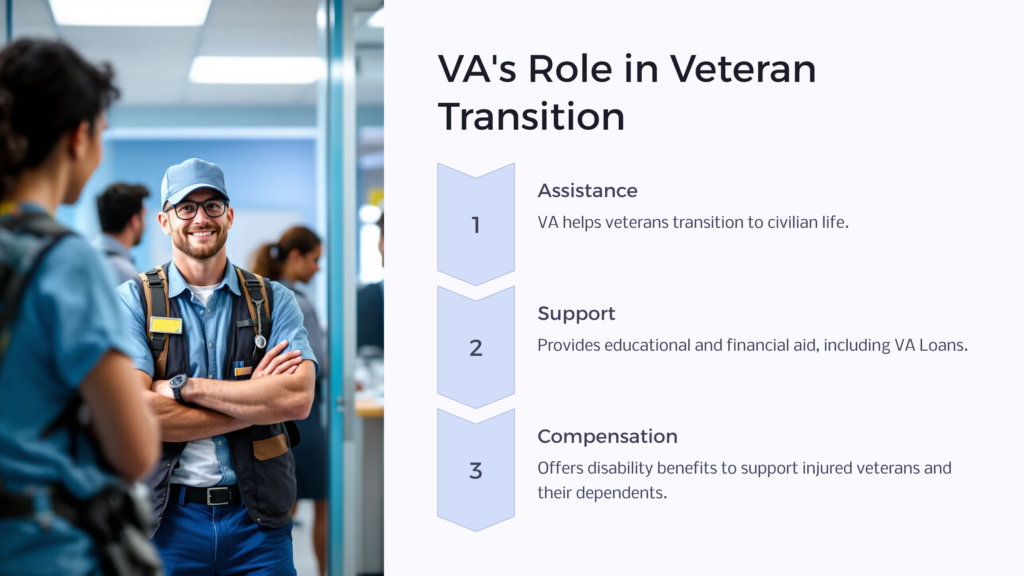In order to receive veterans disability compensation, you must first establish that you have a disability stemming from your military service. Once an eligible condition is identified, your level of disability will be scaled by the VA from 0% to 100%, depending on how much it interferes with your normal life functions.
Understanding the Disability Rating

Monthly benefits are paid to veterans with a disability rating of at least 10%. A 0% rating acknowledges that you have a disability, but that it is not sufficient to entitle you to receive benefits. Even if you receive a rating from 0% – 9% today, it is still worthwhile to have established your claim. If the condition later worsens, you will be glad to have all of the documentation in order.
Payments are graduated according to the degree of disability, from 10% – 100%. A 100% rating means the condition is so disabling that the vet can’t hold steady employment.
VA Disability Benefits are monthly payments made to disabled military veterans. These vets have injuries that prevent them from working—either entirely or to some degree. VA Disability benefits are different for every vet, and calculated using a specific formula.
How To Calculate Your VA Disability Rating
To receive veterans’ disability compensation in the United States, you must first establish that you have a disability stemming from your military service. You can do this by submitting a VA disability claim. Once your VA claim is submitted and reviewed, Veterans Affairs will give you a VA disability rating. And don’t worry, if you have multiple disabilities, the VA will take each into account for a combined disability rating. Your disability rating will be scaled by the VA from 0% to 100%, depending on how much it interferes with your normal life functions.
VA Disability Calculator 2023 Rates
Click to view the complete 2024 VA Disability Pay Chart.
To summarize, here are the 2023 base rates based on disability percentage with no dependents:
10% – $165.92
20% – $327.99
30% – $508.05
40% – $731.86
50% – $1,041.82
60% – $1,319.65
70% – $1,663.06
80% – $1,933.15
90% – $2,172.39
100% – $3,621.95
However, it is important to note that starting at VA disability rating of 30% and up, the compensation a disabled veteran receives will be increased based on the number of dependents under their care, such as a spouse, parents, and children. For example, VA compensation for a disabled veteran with a 100% VA disability rating with one spouse, two parents, and one child can collect a monthly payment of $4,295.92.
A disabled veteran with additional children or a spouse receiving aid and attendance can collect additional disability compensation. For example, a disabled veteran with a 60% VA disability rating can collect an additional disability payment of $55 for every additional child under 18, $178 for every additional child over 18 in a qualifying school program, and $101.66 for every spouse receiving aid and assistance.
As you can see, the exact amount of disability pay varies from veteran to veteran and is based on several factors, including the impact of their disability, marital status, and number of dependents in their care.
VA Benefits are handled by the US Department of Veterans Affairs. This federal organization is responsible for administering healthcare to military vets through locations like a VA hospital or outpatient clinic. They also assist with vocational rehab, education and tuition assistance, benefit payments, home loans, and insurance. The VA also assists with burial and memorializing veterans. In summary, the US Department of Veterans Affairs is responsible for providing veterans and their families with the requisite amount of dignity they deserve for serving their country in war and even in peace.
Unfortunately, some veterans leave their tour of duty with an injury or illness, whether that was sustained in combat or on a base during peacetime. As long as a veteran can prove that their disability was sustained because of and/or during their military service, they are eligible for VA Disability Benefits. However, as mentioned, the way VA Disability Benefits are calculated varies from veteran to veteran.
2024 VA Disability Rates
We’ll include here our projected disability compensation rates for 2024. These adjustments will go into effect as of December 1, 2023. This Cost of Living Adjustment was announced in October of 2023.
| Disability Rating | Veteran (alone, no dependents) |
With Spouse (no children or parents) |
| 30% | $524.31 | $586.23 |
| 40% | $755.28 | $837.84 |
| 50% | $1,075.16 | $1,178.36 |
| 60% | $1,361.88 | $1,486.75 |
| 70% | $1,716.28 | $1,861.79 |
| 80% | $1,995.01 | $2,161.16 |
| 90% | $2,241.91 | $2,428.70 |
| 100% | $3,737.85 | $3,946.25 |
How Do I Get VA Disability Benefits?

You can start your VA disability claim by filing the requisite paperwork in person at a VA Office near you, or by sending them in the mail, or by filling them out online. You will need to gather supporting documents like medical records from a VA Hospital or private medical records. You can also provide supporting documents from friends, family, clergy, or fellow service members. Keep in mind that you will only have one year to submit all your documentation and supporting documents.
As mentioned earlier, even if you think that your VA disability rating will be below 10%, you should still file a claim. If your condition worsens or prevents you from working, it will be easier to file for VA benefits later, as your documentation will be in order with the VA. Additionally, you can’t be entirely sure what VA disability rating will be assigned to you, so it’s always worth filling out the paperwork and getting documentation together.
Remember: average amount of time it takes for the VA to process a disability claim and render a decision is 106 days, so the longer you wait, the more you jeopardize getting the monthly benefits you need. Moreover, supporting documentation from other service members, family, friends, and clergy can build your case. If you wait too long, the possibility to leverage this supporting documentation may disappear, due to memory or even death.
The VA will also review your discharge papers (DD-214 or other separation documents). While you are not required to furnish written evidence of your claim, if you don’t, you will need to schedule an in-person exam with the VA. On average, it takes around 106 days for the VA to decide on your claim. In most cases, a VA disability claim will need to be accompanied by a separate Intent to File form, which will set the date you can begin receiving VA disability compensation. If you submit an Intent to File before applying for VA disability pay, you may be able to secure retroactive VA disability back pay. Note that if you file your VA disability claim online, you do not need a separate intent to file form.
The VA is a Federal Organization created to help veterans by providing the requisite care they need. Don’t be afraid to call the VA or ask for in-person assistance at the local regional office of VA affairs. Some individuals who need help filling out their VA benefits claim may choose to work with a VSO or Veterans Service Officer.
Can I Get VA Disability and Social Security Disability Benefits?
It is possible to receive both VA Disability Benefits and SSDI at the same time. However, if your VA Benefits total over $1,260, you may not be eligible for SSDI benefits, unless you can show that your most recent non-military employment provided income of a greater amount than that. Social Security Disability Insurance (SSDI) is provided to individuals whose work history has furnished a significant number of credits to collect monthly benefit payments should they become unable to work because of an injury or illness that prevents them from working or will result in death.
By contrast, VA benefits have nothing to do with employment or work history and are only awarded based on injuries or illness sustained during military service. Veterans can also collect Supplemental Security Income (SSI) if they need, but their VA Benefits will be factored into the calculations of the SSA as unearned income, which may reduce their SSI monthly benefit payment.
Speaking of collecting disability compensation in conjunction with other benefits like unemployment or general disability pay, don’t write off collecting disability benefits from the VA if you already collect military retirement pay. Military retirees receiving a pension may still be eligible for disability compensation from the VA, for instance, if you have developed an illness that can be traced back to your active duty. In some instances, a disease that is not manifested until years after military retirement may necessitate the services of legal counsel to recover a monthly benefit payment.
Additional Payment Details
In some cases, other types of assistance being paid out to veterans may offset the level of disability payment. You may get paid less for your disability because they will take other VA compensation into account. These offsets include retirement pay from the military, disability severance pay, Special Separation Benefits and Voluntary Separation Incentives.
Veterans disability compensation is a tax-free monthly payment. Most Veterans receive their disability payments via direct deposit to their bank or credit union account. You can also choose to have your benefits mailed by paper check, or sent via a prepaid debit card — even if you do not have a bank account.
How Can I Be Sure They Rate My Disability Accurately?

The best way to ensure that you receive the proper rating for your disability is to file a well-detailed claim backed up with solid evidence. Experts advise that when you apply, focus less on naming your condition than on listing all of your symptoms. The VA is obligated to follow-up on each symptom listed, and those symptoms may point to more or different conditions than you were aware of. This will help them assign the most accurate rating for your disability.
Also, be aware that if you are receiving compensation for a disability and that condition worsens, you can apply to have your claim evaluated for an increase in the disability rate. The VA emphasizes the importance of fully developing your claim.
I am Rated 40% By the VA for One Disability and 10% for Another. Why Isn’t My Overall Rating 50%?
If a VA compensation claim results in a benefit approval, the VA will assign a disability rating. A VA benefit award can result in a combination of several disabilities, which are rated at different percentages.
For example, a veteran can have one rating of 40% for a back injury, a rating of 10% for tinnitus, and a rating of 20% for a knee injury. The combined rating is not the sum of the individual ratings. In this example, the combined rating is not 70% (i.e., the total of each individual rating, 40% + 10% + 20%). Rather the combined rating is 60%.
The combined rating is based upon a series of calculations, which the VA describes as the efficiency to perform work factor. The calculations begin with sorting the individual rating percentages descending from the highest to the lowest rating. In the example under consideration, you sort the percentages descending from 40% to 20% to 10%. Then, subtract the highest from 100% (which results in 60%).
When the VA establishes that the veteran is 40% disabled for the back injury, that veteran has a remaining efficiency to perform work at a 60% level. Then, looking at the example, the veteran is 20% disabled from the knee injury. The next calculation takes this efficiency into account. According to the VA, the veteran can only perform 20% times the 60% of the remaining efficiency, which is 12%. The VA adds this remaining efficiency rating to the first rating of 40%, which results in a combined rating of 52%.
The next step is to account for the 10% rating for tinnitus. The VA subtracts the result of the last step 52% from 100%, which gives us the remaining efficiency to perform work of 48%. The VA multiplies 48% times 10%, which produces 4.8%, rounded up to 5%. They then add the first stage combined rating of 52% to the second stage of 5%. The total is 57%. The final number is rounded up to 60%. It is not the 70% rating that you would have anticipated it to be by simply adding all three ratings together.
If the example considered here had had more than three individual ratings, then more calculations would have been needed to take into account the efficiency to perform work for the other additional individual ratings.
VA Disability Rating and Compensation

The VA is responsible for assisting veterans with a peaceful transition back to civilian life, which may include educational or financial assistance like VA Loans. But for vets who have become disabled due to military service, reacclimating to the employment component of civilian life can be difficult, both emotionally and in terms of generating sufficient income to support themselves and/or dependents. The VA will step in to alleviate this burden and give an injured vet the dignity and assistance they deserve in repayment for serving their country.
As we’ve seen, the exact amount of disability compensation provided by the VA depends on a VA disability rating that reflects the impact of a disability on a vet’s ability to work. If they have multiple injuries, the VA will leverage a formula to find the combined VA disability rating. And lastly, if a veteran has dependents such as a spouse, children, or parents in their care, they may receive additional compensation.
 Benefits.com Advisors
Benefits.com Advisors
With expertise spanning local, state, and federal benefit programs, our team is dedicated to guiding individuals towards the perfect program tailored to their unique circumstances.
Rise to the top with Peak Benefits!
Join our Peak Benefits Newsletter for the latest news, resources, and offers on all things government benefits.


















